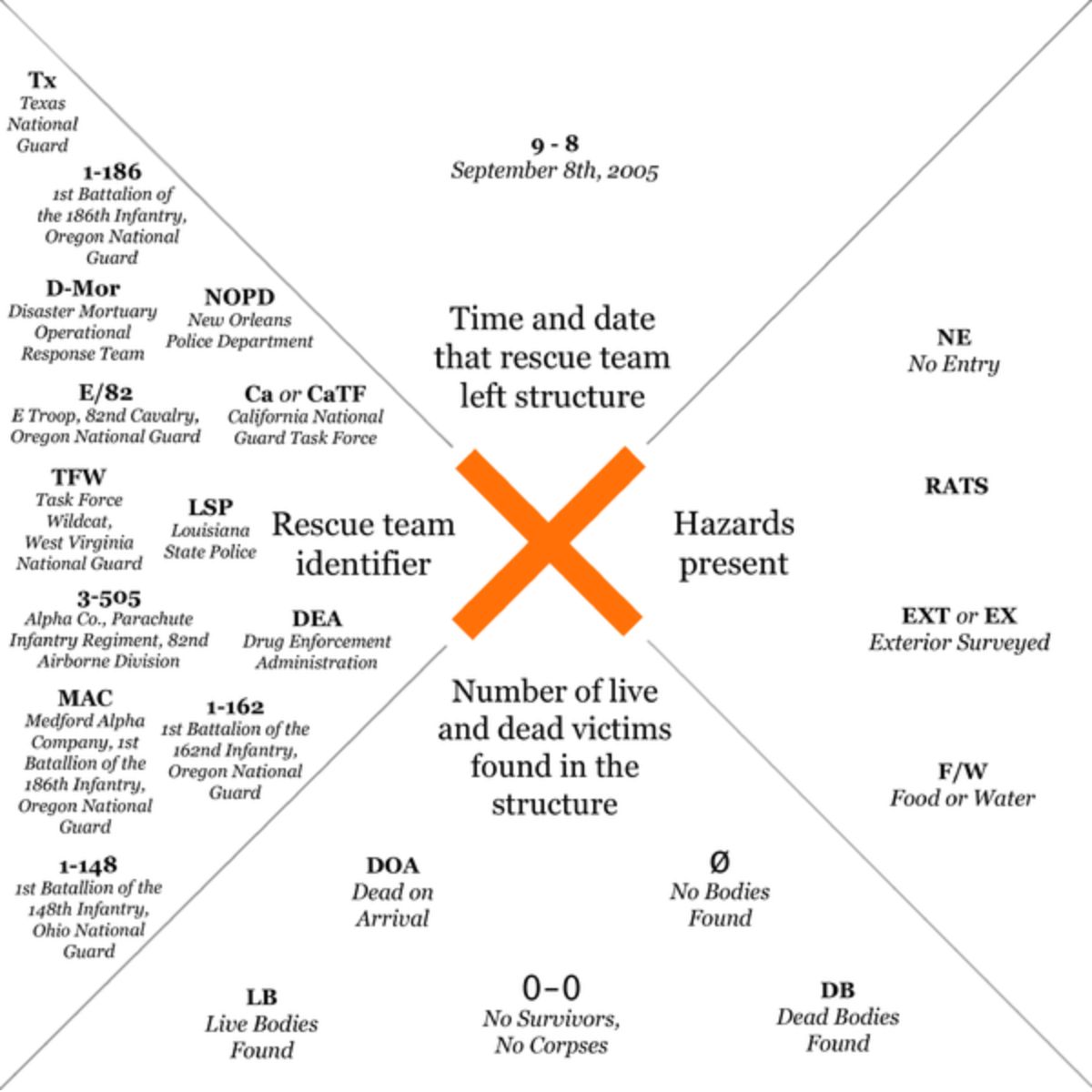Urban search and rescue markings littered homes after major disasters, such as Hurricane Katrina. The spray paint has been long removed or covered, but the legacy remains. To many, what they mean is a mystery- but it doesn’t have to be that way. We’ll give you a quick crash course on USAR markings and why they are important.
What are Urban Search and Rescue Markings?
These markings are sprayed on the side of residences searched by FEMA (Federal Emergency Management Agency) responders. The markings meaning is broken down as follows:
- Single Slash: This means that FEMA responders have gone inside and that a building search is in progress. This helps reduce duplication of search efforts and lets other responders know where their teams are searching.
- X with Writing in Quadrants: This means that a search has been completed.
- Left Quadrant: Search team’s identifier “tag”, usually a short acronym or military number.
- Top Quadrant: Time and date search team left the building.
- Right Quadrant: List of hazards present (if any)
- Bottom Quadrant: Number of survivors and bodies found. Usually noted in that order: 0/0 for no survivors and no corpses.
- X with a Box around it: This means “Do Not Enter”, usually because it is dangerous.
Here is a photo essay with many examples from Hurricane Katrina: Katrina + 5: An X-Code Exhibition.
Here is an example with all of the USAR marks used during Hurrican Katrina:

What Does This Mean for a Resourceful Prepper in an SHTF Scenario?
If you are out and about after a disaster, now you can easily see what is going on at buildings that have been searched. Seeing a single slash on a building could also let you know that a search party is near; whether you are looking to encounter them or not. You can visit friends’ homes nearby and be able to tell if they were searched, what time, by who, and how many survivors and dead were found. That is a good amount of information for a little graffiti on the wall! That brings us to the second useful ability to know the FEMA markings.
Not only can you read the markings, but if SHTF gets really nasty, you can write a marking. A large X with a box around it on the side of your house tells search parties, the military, and others who know the markings that it is not safe to enter your house. Paired with light and noise discipline, this could be a great deterrent to intruders in an SHTF scenario.
Since your house may not look particularly dangerous, tagging the FEMA X and filling in some info may be the better choice. It may be more believable that your house was searched and passed over already rather than just too dangerous to enter. A foolproof tag that most national guard units would use is simply your state abbreviation in the left quadrant. Keeping a can or two of spray paint in your disaster kit may be a good idea.
The Final Word
While all of this is good knowledge, I hope you never have to use it. The probabilities are slim that you encounter a disaster where these are used, but there is a chance knowing the Urban Search and Rescue markings could help. Check out our TrueRisk index for more likely scenarios, and make sure you are prepared for those as well.
- INSARAG Search and Rescue Markings
- The Best Survival Pen for EDC
- Bug Out Bag (BOB) Guide, Gearl List, and Checklist
Keep exploring, stay prepared, and be safe.
You’ve Been Missing Out
Join the 2+ million preppers that rely on our prepping advice by subscribing to TruePrepper.
- Practical guides and tips
- Useful survival giveaways
- Free, forever
- < 0.4% of people unsubscribe
Thanks for subscribing, reading, and welcome to the club.
The post FEMA Urban Search and Rescue Markings Guide for Survival appeared first on TruePrepper.
By: Rusty Collins
Title: FEMA Urban Search and Rescue Markings Guide for Survival
Sourced From: www.trueprepper.com/urban-search-rescue-markings-know/
Published Date: Sat, 01 Jul 2023 11:23:03 +0000
-------------------------------------------------------------------------
Did you miss our previous article...
https://outdoorsnewswire.com/survivalist/longterm-coffee-storage-get-it-to-last-5-years
 CampingSurvivalistHuntingFishingExploringHikingPrivacy PolicyTerms And Conditions
CampingSurvivalistHuntingFishingExploringHikingPrivacy PolicyTerms And Conditions
